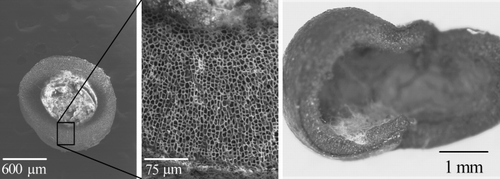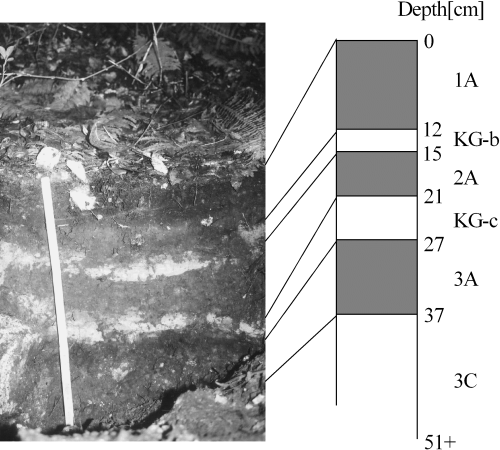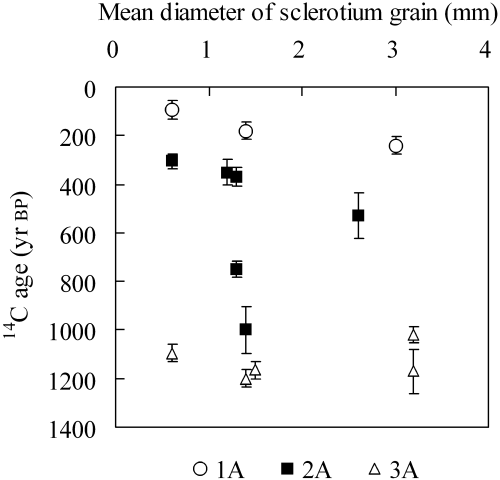Abstract
14C ages and δ13C were examined for sclerotium grains to elucidate the characteristics of these grains distributed in forest soils. The ages of the grains from surface A horizons and buried A horizons were ca 100–200 bp and ca 300–1,200 bp, respectively. In comparison with humic acid extracts, the 14C ages were in the increasing order: humic acid fraction < humic acid Pg fraction < sclerotium grains. The δ13C values for sclerotium grains in surface A horizons and buried A horizons were approximately −31‰ to −28‰, and these values were approximately 2–4‰ smaller than those of humic acids and soils. The C content of the grains had a tendency to decrease with increasing 14C ages, while the C content of humic acid was constant with age. The 14C ages of sclerotium grains indicate the individual age of grain formation, which are more likely to assign closer ages to the beginning of soil forming than the 14C ages of humic acid. The low δ13C values for sclerotium grains have presumably originated from characteristically biological organics, which may be protected from attack in soils because of their structure.
INTRODUCTION
Mycelium of fungal species such as Deuteromycetes, Ascomycetes and Basidiomycetes are known to form resting bodies called sclerotia. Sclerotia have small spherical black bodies (with a diameter of ∼0.5–1.5 mm) protected by thick, melanin-pigmented walls, and are considered to be resistant to attack and desiccation during the period of inactivity (CitationCochrane 1958; CitationFox 1986; CitationGray and Williams 1971). Sclerotium grains () found in forest soils are assumed as the resting structure of an ectomycorrhizal fungus, ‘Cenococcume geophilum’, and as one of the sources of the green fraction of P type humic acid (so called ‘Pg’) by CitationKumada and Hurst (1967). CitationKumada and Hurst (1967) examined sclerotium grains in British and Swedish Podzols and showed that the distribution density of the grains tended to be greater in B horizon than in A horizon. CitationRetallack (1990) introduced similar spherical grains found in paleosol as indicators for reducing condition. CitationHormes et al. (2004) examined C. geophilum spores in paleosols of moraines in Lapland, northern Sweden, and reported that the 14C ages of the spores were 5,000–6,000 bp.
CitationWatanabe et al. (2001) reported high concentrations of Al in sclerotium grains collected from volcanic ash soils and the possible occurrence of Al–humus complexes inside the grains. Sclerotium grains had a tendency to exist in soils with high ratios (> 0.5) of organic bonding Al (Alp: pyrophosphate-extractable Al) to amorphous Al (Alo: acid ammonium oxalate-extractable Al) regardless of soil type and the maximum density of the sclerotium grains was approximately 2.5 g kg−1 soil (CitationWatanabe et al. 2002, Citation2004b). Furthermore, a highly positive relationship was observed between the mean weight of the sclerotium grains and the content of exchangeable aluminum (Al3+) in the soils. CitationWatanabe et al. (2006) examined the characteristics of major and trace elements in sclerotium grains collected from volcanic ash soils at Mount Myoko. The content of the major elements C, H, N, O and Al were approximately 47.6, 3.32, 0.78,
30.2 and 1.4% by mass, respectively, and trace elements such as Ti, Cr, Mn, Cu, Zn, Br and Pb were detected at concentrations between 10 to 100 µg g−1. Carbon in sclerotium grains was mainly composed of O-alkyl C and the contribution of aromatic C was less important than that in humic acid, which showed strongly a characteristically biological origin and completely different features to humic and fulvic acids from an allophanic Andosol.In the present study, 14C ages and stable isotope ratio δ13C were examined for sclerotium grains and for humic acid extracts in equivalent layers to obtain further knowledge regarding the characteristics of sclerotium grains as an organic component in forest soils and to discuss the interpretation of 14C ages assigned for the remaining grains in soils.
MATERIALS AND METHODS
Samples of sclerotium grains were collected from Myoko Asadaira soil, central Japan (Fulvic Andosol, World Reference Base/Food and Agriculture Organization–Unesco; location, 36°54′N 138°8′E; elevation, 1,330 m; vegetation, Fagus crenata). As described in , sclerotium grains were collected from the surface A horizon and the buried humic horizons beneath KG-b (Koyaike ash-b) and KG-c (Koyaike ash-c), the tephra deposits derived from the Yakeyama volcano in 650 ± 100 bp and 950 ± 80 bp (CitationHayatsu et al. 1994), respectively. Sclerotium grains larger than 1 mm in diameter were picked up from air-dried soils using sterilized tweezers. Grains smaller than 1 mm in diameter were collected from the float of distilled water. Sclerotium grain samples were exposed to ultrasonic treatment for 5 min to remove soil from their surface and then dried at room temperature. The weight and diameter of the grains were measured using an electronic balance and a digital high-density video microscope (VH-7000, Keyence, Osaka, Japan), respectively. Samples were fractionated into three grain sizes; large (> 2 mm), medium (∼1–2 mm) and small (< 1 mm). Soil samples for 14C age determination were prepared by removing sclerotium grains larger than 0.2 mm in diameter. Soil humic acids were extracted from horizons 1A, 2A and 3A of the Myoko Asadaira soil using the repeating Acid–Alkaline–Acid (AAA) treatment developed by CitationNakamura and Iwahana (1990). The humic acid Pg fraction was prepared using the following procedure. First, humic acid from Myoko soil was prepared using the International Humic Substances Society (IHSS) method (CitationSwift 1996). A 50-mg sample of humic acid was dissolved in 3 mL of 0.2 mol L−1 NaOH, and then 0.3 mol L−1 NaCl (3 mL) was added to the solution. The solution was filtered through a membrane filter (0.2 µm, PTFE, Billerica Corp., Milford, MA, USA), and the filtrate was applied onto a glass column of Sephadex G-50 gel (Amersham Bioscience, Piscataway, NJ, USA; column size, ϕ50 mm × 30 cm). The column was eluted with 0.1 mol L−1 NaOH at a flow rate of 220 mL h−1. The first brown fraction and the second greenish brown fraction were discarded, and then the green fraction, which was finally eluted, was collected. The green fraction was immediately acidified with 1 mol L−1 HCl to below pH 2. The same purification procedure was repeated several times. The combined acidified solutions were placed in the dark at 4°C for 3 days, and the supernatant was removed by centrifugation (22,000 g, 30 min). The precipitate was dialyzed with distilled water for 1 week using a Spectra/Por dialysis membrane (MWCO 3500, Spectrum Laboratories, Houston TX, USA), and then it was freeze-dried. The obtained powder was then used as a Pg sample.
Accelerator mass spectrometry (AMS) measurements for 14C/12C ratios were carried out at Micro Analysis
Laboratory (MALT) (5 MV Tandem accelerator), at the University of Tokyo, Japan, according to CitationMatsuzaki et al. (2004). As 1 mg C is required for the AMS measurement, the number of grains used for AMS measurement was determined by grain size as noted in . All samples were oxidized to CO2 gas. The CO2 gas was purified and then graphitized using hydrogen gas and Fe powder as catalysis. Graphite samples were pressed with Fe powder into cathode cones to be set at the ion source of the AMS system. The 14C/12C data of samples were normalized using the 14C/12C of the standards. New oxalic acid provided by National Institute of Standards and Technology (NIST) (SRM 4990C) was used as a standard material. 14C ages were calculated according to the procedures of CitationStuiver and Polach (1977) and calibration for calendar age was carried out using the INTCAL98 and OxCal calibration program v3.9 of CitationRamsey (1995, Citation2001). The AMS measurement was repeated four times for each sample. The accurate δ13C values of sclerotium grains were determined using an isotopic ratio mass spectrometer (IRMS) according to the following procedure. Samples containing approximately 0.1 mg of C were weighed into tin capsules. Each sample was prepared by repeating the measurements three times. Samples were combusted in a C/N analyzer (EA-1108, Fison Milan, Italy), and the combustion product (CO2) was directly introduced into an IRMS (Finigan Mat 252 Thermo, Waltham, MA, USA). The δ13C was expressed as follows:RESULTS AND DISCUSSION
shows the results of the 14C age measurement for sclerotium grains and humic acids. represents the distribution of 14C ages of sclerotium in the profile of Asadaira, Myoko. Grains found from horizon 1A, 2A and 3A were 95 ± 40 to approximately 240 ± 35 bp, 305 ± 30 to approximately 1,000 ± 95 bp, and 1,020 ± 35 to approximately 1,200 ± 35 bp, respectively. The obtained ages were not calibrated for calendar age in discussions hereafter because of the large variation in CO2 in air in the past 200 years. The 14C ages for the
Table 1 14C ages determined using accelerator mass spectrometry
Figure 3 Distribution of 14C ages of sclerotium in the profile of Myoko Asadaira soil. KG-b, Koyaike ash-b; KG-c, Koyaike ash-c.
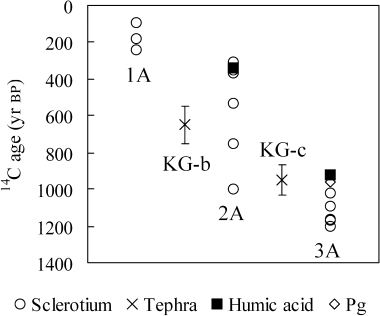
The average 14C ages for the soil humic acids extracted from horizons A, 2A and 3A in Myoko Asadaira soil were modern (< 0 bp), 340 ± 45 bp and 920 ± 50 bp, respectively. These ages were younger than those of sclerotium grains found in equivalent horizons. The green fraction of humic acid (so called Pg) extracted from the 3A horizon was 959 ± 37 bp. Although sclerotium grains are considered to be a possible origin of humic acid Pg (CitationKumada and Hurst 1967), the age of the Pg extract was slightly older than humic acid, but still younger than sclerotium grains.
The relationships between 14C age and grain size obtained for the Myoko profile are shown in . Grains younger than 600 bp, collected from horizons 1A and 2A, showed a slight tendency to increase their ages with an increase in diameter, while there was no clear relationship between age and size for grains older than 600 bp. Relatively small grains (1–2 mm) had a spherical shape and larger grains (> 2 mm) frequently found in horizon 3A of Myoko soil were likely to have a distorted shape (as previously shown in ). It could be inferred that several small grains conjunct to form a single large grain and this might be one of the reasons that the relationship between 14C age and grain size was not clear for larger grains in buried A horizons.
Although difficulties remain in comparing 14C ages between humus extracts and sclerotium grains, it was considered that the average age of organic materials responsible for forming sclerotium grains is older than
that of humic substances. Most of the sclerotium grains examined in our paper are supposedly equivalent to “dead” sclerotia of C. geophilum, which were characterized as hard and brittle, and evidently persist as spores in the soil in contrast to the “live” sclerotia of C. geophilum recorded by CitationTrappe (1969) and CitationMassicotte and Trappe (1992). In studies of sclerotium germination and formation in vitro, initial growth of the white hyphal tip from field collected “live” sclerotia on agar elapsed within 10 days (CitationTrappe 1969) or at the latest within 20 days (CitationMassicotte and Trappe 1992). Hyphal growth was detected on most sclerotia that proved to be viable within 30 days, but some sclerotia sat on the agar for up to 75 days before showing germination and at maturity, after the formation of a dark rind, they resembled sclerotia formed in soil (CitationMassicotte and Trappe 1992). Based on these studies, it is plausible that sclerotium formation in soils may also terminate within several months. Humic acids continuously exposed to metabolism are composed of heterogeneous material. In contrast, sclerotium grains, existing as a spore structure derived from the cell walls of fungals, are likely to be composed of homogeneous material. Consequently, the AMS 14C ages of sclerotium grains are the remaining ages of individual grain and assign closer ages to the beginning of soil formation compared with humic acids, which may assign the average age of soil humus.As a high concentration of Al is detected in the cortex cell wall of ectomycorrhizas (CitationBrunner 2001; CitationBrunner and Frey 2000), the homogeneous distribution of Al in the transverse wall of ignited grains observed by CitationWatanabe et al. (2004a) suggests that the grains themselves are the
Figure 5 The relationship between 14C ages of sclerotium grains and carbon content (%) measured using a CO2 pressure gauge in the process of graphite preparation.
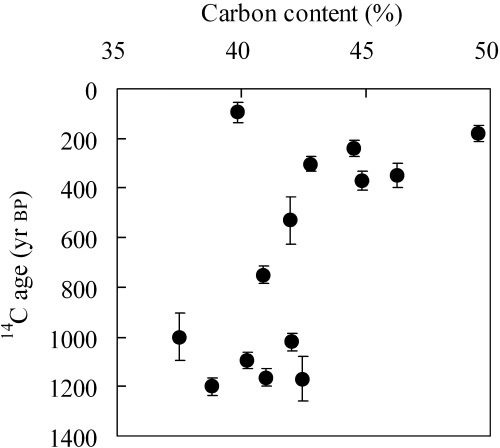
According to , in which C content was measured using a CO2 pressure gauge through the process of preparing graphite, C content for sclerotium grains in surface A horizons was approximately 40–50%, while the content in buried A soils was approximately 38–46%. The values show a slight decrease in C content in the older grains as represented in , and the same tendency is recognized for the C content measured by IRMS in , where C content of the grains is represented by the horizons. These results suggest that sclerotium grains in buried humic soils are in the process of decomposition.
The δ13C measurements for Myoko sclerotium grains demonstrated that grains from 1A had a δ13C value ranging from −28.88 ± 0.20 to approximately −31.36 ± 0.16‰, while the δ13C values for the grains from buried horizons 2A and 3A were −28.63 ± 0.19 to approximately
Figure 6 (a) δ13C and (b) carbon content for Myoko Asadaira sclerotium grains measured using an isotopic ratio mass spectrometer.
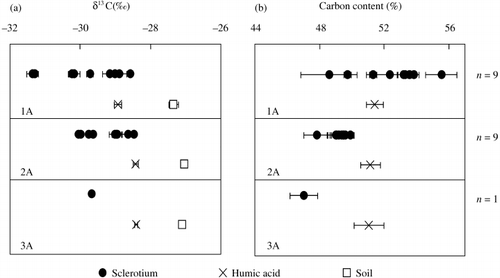
CitationWatanabe and Takada (2006) reported an association between chemical structure and δ13C of humic acids in buried volcanic ash soils and clarified the increase in δ13C values in older humic acids, which had a relatively high content of aromatic C. The solid-state cross polarization and magic angle spinning (CPMAS) 13 C-NMR spectrum observed by CitationWatanabe et al. (2006) for the Myoko sclerotium grains showed intense signals of O-alkyl C at 75 and 105 p.p.m., which were assigned to C2 to C6 and C1 positions of sugar chains, respectively, and a less intense signal at 130 p.p.m. (aromatic C), accompanied by minor signals of 175 p.p.m. (carboxylic C), 60 p.p.m. (methoxyl C) and 20 p.p.m. (methyl C). Considering the above knowledge together with the results of the 14C ages obtained in the present study, sclerotium grains are probably formed in advance of humic acid formation and their initial chemical structure is preserved in the grain. According to CitationTrappe (1969) and CitationMassicotte and Trappe (1992), the firm live sclerotia contained a large amount of ethanol-soluble oil. The low δ13C values obtained from sclerotium grains may originate from characteristic organic compounds that are difficult to purify from soil humus.
Studies on microbial communities of sclerotium grains by CitationOhta et al. (2003) found Sphingomonas spp., which could use benzoic acid and phenolic acid compounds, to be a dominant bacteria existing in the cell structures of grains collected from Myoko soil. Further investigation may explain the change in δ13C with age, which may occur because of activities of microorganisms in the grain. A high precision isotope micro-imaging technique using a secondary ion mass spectrometry (SIMS) with a solid-state ion imager (CitationKunihiro et al. 2005; CitationNagashima et al. 2004; CitationYurimoto et al. 2003) might be able to assist in observing the low δ13C part on the surface of cell structures in the grain.
CONCLUSION
Sclerotium grains of C. geophilum in Japanese forest soils were characterized by AMS 14C age determination and IRMS δ13C measurement and compared with soil humic acid. The 14C ages of sclerotium grains were older than those of humic acid extracts in equivalent soil horizons. The 14C ages of humic acids are more likely to reveal the mean age of humus, while the 14C ages of sclerotium grains indicate the individual age of grain formation. Older grains remaining in soils may provide an age close to the start of soil formation, or preserve past records of the soil environment. The decrease in C content for sclerotium grains suggested a process of decomposition or degeneration of C in the grains mainly because of internal microbial activities. The low δ13C values for sclerotium grains (approximately −28 to −32‰) compared with soil and humic acids presumably originate from characteristically biological organics.
ACKNOWLEDGMENTS
The authors thank the Sumitomo Science Foundation and the Japan Society for the Promotion of Science for their financial support for this study.
REFERENCES
- Cochrane , VW . 1958 . Physiology of Fungi , New York : John Wiley & Sons .
- Fox , FM . 1986 . Ultrastructure and infectivity of sclerotium-like bodies of the ectomycorrhizal fungus Hebeloma sacchariolens, of birch (Betulaspp.) . TransBrMycolSoc , 87 : 359 – 369 .
- Gray , TRG and Williams , ST . 1971 . Soil Micro-Organisms , Edinburgh : Oliver & Boyd .
- Kumada , K and Hurst , MH . 1967 . Green humic acid and its possible origin as a fungal metabolite . Nature , 214 : 631 – 633 .
- Retallack , GJ . 1990 . Soils of the Past , Boston : Unwin Hyman .
- Hormes , A , Karlen , W and Possnert , G . 2004 . Radiocarbon dating of palaeosol components in moraines in Lapland, northern Sweden . Quaternary SciRev , 23 : 2031 – 2043 .
- Watanabe , M , Fujitake , N , Ohta , H and Yokoyama , T . 2001 . Aluminum concentrations in sclerotia from a buried humic horizon of volcanic ash soils in Mt. Myoko, Central Japan . Soil SciPlant Nutr , 47 : 411 – 418 .
- Watanabe , M , Kado , T , Ohta , H and Fujitake , N . 2002 . Distribution and development of sclerotium grain as influenced by aluminum status in volcanic ash soils . Soil SciPlant Nutr , 48 : 569 – 575 .
- Watanabe , M , Ohishi , S Pott , A . 2004b . Morphology, chemical properties and distribution of sclerotium grains found in forest soils, Harz Mts., Germany . Soil SciPlant Nutr , 50 : 863 – 870 .
- WatanabeM InoueY SakagamiNet al.2006 Characterization of major and trace elements in sclerotium grains EurJSoil Sci doi: 10.1111/j.1365-2389.2006.00868.x
- Hayatsu , K , Shimizu , S and Itaya , T . 1994 . Volcanic history of Myoko Volcano Group, Central Japan – Poly-generation volcano . JGeogr , 103 : 207 – 220 .
- Nakamura , T and Iwahana , H . 1990 . Comparison of 14C ages by accelerator mass spectrometry between solid-carbon and humic-acid ingredients from charcoal remains collected at Moroka site, Gifu Prefecture . ArchaeolNatl Sci , 22 : 59 – 76 . (in Japanese with English abstract)
- Swift , RS . 1996 . “ Organic matter characterization ” . In Methods of Soil AnalysisPart 3Chemical Methods , Soil SciSocAmBook Series: 5 Edited by: Sparks , D , Page , A Helmke , P . 1018 – 1020 . Madison : Soil Sci. Soc. Am. .
- Matsuzaki , H , Nakano , C Yamashita , H . 2004 . Current status and future direction of MALT, The University of Tokyo . NuclInstrMethPhysRes , B223–224 : 92 – 99 .
- Stuiver , M and Polach , HA . 1977 . Discussion reporting of 14C data . Radiocarbon , 19 : 355 – 363 .
- Ramsey , CB . 1995 . Radiocarbon calibration and analysis of stratigraphy: The OxCal Program . Radiocarbon , 37 : 425 – 430 .
- Ramsey , CB . 2001 . Development of the radiocarbon program OxCal . Radiocarbon , 43 : 355 – 363 .
- Trappe , JM . 1969 . Studies on Cenococcum graniforme. I. An efficient method for isolation from sclerotia . CanJBot , 47 : 1389 – 1390 .
- Massicotte , HB and Trappe , JM . 1992 . Studies on Cenococcum graniforme. II. Sclerotium morphology, germination, and formation in pure culture and growth pouches . CanJBot , 70 : 125 – 132 .
- Brunner , I . 2001 . Ectomycorrhizas: their role in forest ecosystems under the impact of acidifying pollutants . PerspectPlant EcolEvolSyst , 4 : 13 – 27 .
- Brunner , I and Frey , B . 2000 . Detection and localization of aluminum and heavy metals in ectomycorrhizal Norway spruce seedlings . EnvironPollut , 108 : 121 – 128 .
- Watanabe , M , Genseki , A , Sakagami , N , Inoue , Y , Ohta , H and Fujitake , N . 2004a . Aluminum oxyhydroxide polymorphs and some micromorphological characteristics in sclerotium grains . Soil SciPlant Nutr , 50 : 1205 – 1210 .
- Hiradate , S , Nakadai , T , Shindo , H and Yoneyama , T . 2004 . Carbon source of humic substances in some Japanese volcanic ash soils determined by carbon stable isotopic ratio, δ13C . Geoderma , 119 : 133 – 141 .
- Smith , BN and Epstein , S . 1971 . Two categories of 13C/12C ratios for higher plants . Plant Physiol , 47 : 380 – 384 .
- Hobbie , EA , Macko , SA and Shugart , HH . 1999 . Insights into nitrogen and carbon dynamics of ectomycorrhizal and saprotrophic fungi from isotopic evidence . Oecologia , 118 : 353 – 360 .
- Watanabe , A and Takada , H . 2006 . Structural stability and natural 13C abundance of humic acids in buried volcanic ash soils . Soil Sciand Plant Nutr , 52 : 145 – 152 .
- Ohta , H , Yagi , M , Suzuki , J , Fujitake , N and Watanabe , M . 2003 . Characterization of Sphingomonasspecies found as predominant members in the culturable bacterial community of a green pigment-containing sclerotium grain from Mt. Myoko (Japan) volcanic ash soil . Microbes Environ , 18 : 126 – 132 .
- Kunihiro , T , Nagashima , K and Yurimoto , H . 2005 . Microscopic oxygen isotopic homogeneity/heterogeneity in the matrix of the Vigarano CV3 chondrite . Geochimica et Cosmochimica Acta , 69 : 763 – 773 .
- Nagashima , K , Krot , AN and Yurimoto , H . 2004 . Stardust silicates from primitive meteorites . Nature , 428 : 921 – 924 .
- Yurimoto , H , Nagashima , K and Kunihiro , T . 2003 . High precision isotope micro-imaging of materials . ApplSurfSci , 203–204 : 793 – 797 .
